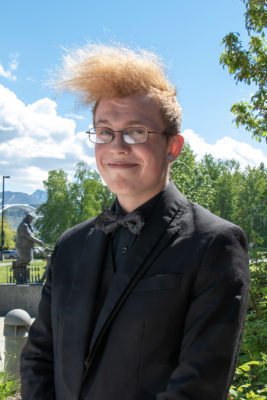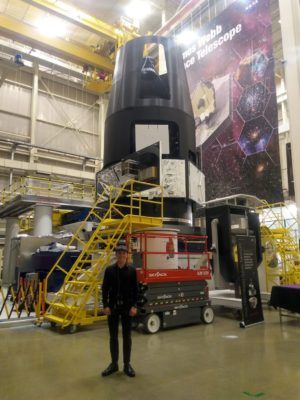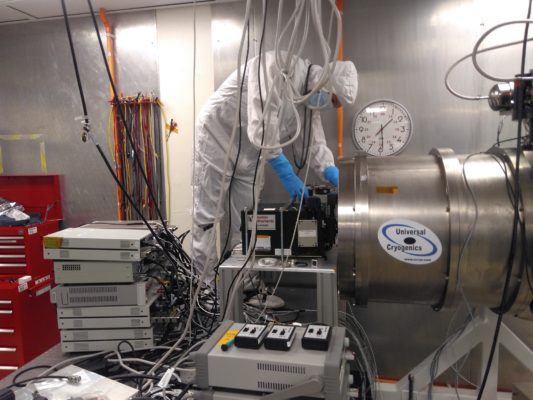To NASA and back
by Catalina Myers |

Electrical engineering junior Brett Keene spent 10 weeks at NASA's Goddard Space Flight Center in Maryland for his summer internship. (Photo courtesy of Brett Keene)
Brett - Ivan, as his friends call him - Keene, is an Alaska boy through and through. The UAA electrical engineering major, who is entering his junior year this fall, had his entire summer planned full of camping trips, hiking, fishing and a trip to Italy, as well as a full-time job. But when he learned that he'd landed an amazing internship opportunity at NASA's Goddard Space Flight Center (GSFC) in Maryland, supported by the Alaska Space Grant Program, he did what most Alaskans do at the thought of leaving the state in the summer. He hesitated.
"I had major plans this summer, but when I got the NASA acceptance letter, I had to decide what was more important," Keene said. "I didn't expect to get accepted to the program this summer."
But with a little coaxing from his boss, he decided to swap hiking boots and cool mountain breezes for a lab coat, goggles and a hot and humid East Coast summer.
Civil Servant
When Keene had initially applied for an internship last fall, he was looking for an opportunity that would land him somewhere in the sphere of electrical engineering and would also include circuitry and hands-on laboratory elements. The NASA internship happened to be the first one he applied to, although there were many options of what type of internship and focus each one would have. Keene opted for the internship focused on using instrumentation under cryogenics and light characterization.

Keene taking a photo-op in front of one NASA GSFC's telescopes during his internship this summer. (Photo courtesy of Brett Keene)
"For me, this [internship] sets me on the route I want to be since it gets me closer to particle physics," Keene said.
Keene said when he boarded his Alaska Airlines flight in Anchorage bound for the East Coast, he had few details of his internship, other than basic details of where to report his first day and where he'd be living during the next 10 weeks.
On his first day, he received his official badge with the title of "Intern" that would allow him on and off NASA's Maryland campus.
"You really don't know what to expect before you arrive; they [NASA] isolate the information they give you and only what they deem necessary," said Keene. Once he arrived at GSFC, he learned he'd be working under a lead detector technician, who was working on NASA's Wide Field Infrared Telescope (WFIRST) project. The WFIRST project is a NASA observatory designed to unlock the mysteries of dark energy and matter, while also searching for and imaging exoplanets using infrared technology and astrophysics. It's a complicated project that involves a lot of math, which Keene said can seem mundane day to day, but is important because it contributes to a much larger picture.
The daily grind
Keene said there are two types of interns at GSFC, those who work in a group environment and those who have solo projects. Keene worked on a solo project, one that he knew was going to test his mettle, but he was determined to give it a shot. For this particular project, Keene said he had to brush up on radiometry, a form of math that deals with light and optical radiation, as well as blackbody radiation. Keene's work on the WFIRST project involved creating a spectral calibration transfer curve for the WFIRST testing apparatus; analyzing the detector's data for quantum efficiency; and checking calibration methods and assessing a recently discovered calibration issue. He said initially his internship was to create the spectral equations, but after inquiring further about the project, he was given more responsibility.
"It will be fun," said Keene laughing, but admitted that it is not something he's completely familiar with. He said in addition to his work on the WFIRST project, he worked in "clean rooms," setting up the cryostats and instruments used to calibrate photodiodes for transfer curves and tested the detectors for quantum efficiency. "From there, I was pretty much doing data analysis, really it varied from day to day, whatever was needed."

Keene covered up in a head-to-toe clean room suit, so as not to contaminate the Clean Room while he performed his daily tasks during his internship at NASA's GSFC in Maryland earlier this summer. (Photo courtesy of Brett Keene)
Keene said an important aspect of his internship was to be willing to learn on the job and to learn about unfamiliar topics. Although he's going into his junior year here at UAA this fall, Keene said during his work at GSFC, he ended up doing graduate-level radiometry. To some, this painstaking work may seem unnecessary, but in NASA terms, it's a very important piece of a giant science puzzle.
Although the work was serious, Keene said the GSFC culture was pretty laid back. He wore what he describes as his "daily uniform" of head-to-toe black and that the dress was casual, except for when he was scheduled to work in the "clean room."
"When going into the clean room, you had to wear a clean room suit that has to be put on in a certain way to avoid any dust particles going into the clean room," Keene said. "The only other thing was that I had to wear a badge at all times stating my internship."
After hours
As an active Alaskan who enjoys the outdoors, Keene took the opportunity to explore his new surroundings in his free time once he punched the clock. He spent his first week scouring the city on his longboard, seeking out a bicycle for the summer.
"I finally found one," he said and pedaled around town, seeking out entertainment in his off-work hours. "I enjoyed going running, biking and seeing the town."
Keene said he's not a sit down and watch Netflix kind of guy - he enjoys spending his evenings and weekends outside in nature. Surprisingly, Keene said Maryland is similar to Anchorage with all the greenery incorporated around the city and greenbelt parks, one of which happened to be close to his apartment. Keene said he also enjoys learning about the different animals in cities that he travels to. He finds the local critters and bugs in different parts of the country fascinating.
"I found a snake and cool lizard," said Keene. "I even found a turtle and that just made my day."
Keene said he enjoyed his time on the East Coast, although the heat got to him and the temperature rose well beyond his Alaskan comfort zone. Additionally, Keene said he was concerned about being away from home for so long. This was his first internship experience and he wasn't quite sure what to expect from the people or the place, but ended up being pleasantly surprised.
"Things were really good and I really enjoyed the experience," Keene said. "Everyone was super friendly."
Written by Catalina Myers, UAA Office of University Advancement
 "To NASA and back" is licensed under a Creative Commons Attribution-NonCommercial 4.0 International License.
"To NASA and back" is licensed under a Creative Commons Attribution-NonCommercial 4.0 International License.














